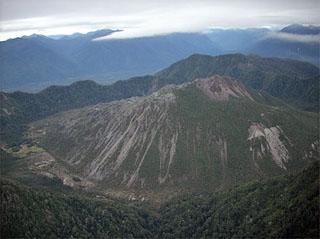Report on Chaiten (Chile) — 4 June-10 June 2008
Smithsonian Institution / US Geological Survey
Weekly Volcanic Activity Report, 4 June-10 June 2008
Managing Editor: Sally Sennert.
Please cite this report as:
Global Volcanism Program, 2008. Report on Chaiten (Chile) (Sennert, S, ed.). Weekly Volcanic Activity Report, 4 June-10 June 2008. Smithsonian Institution and US Geological Survey.
Chaiten
Chile
42.8349°S, 72.6514°W; summit elev. 1122 m
All times are local (unless otherwise noted)
SERNAGEOMIN reported that during an overflight of Chaitén on 3 June, the lava dome appeared more extensive and voluminous as compared to previous observations. About 2500 hectares (6,200 acres) of forest on the N and NE flanks of the volcano were burned by pyroclastic flows or lateral explosions. During 3-10 June ash-and-steam plumes rose to a maximum altitude of 3 km (10,000 ft) a.s.l. and drifted SE. Abundant steam plumes were noted. The Alert Level remained at Red.
Based on observations of satellite imagery, SIGMET reports, and pilot observations, the Buenos Aires VAAC reported that during 4-9 June continuous ash plumes rose to altitudes of 1.8-7.3 km (6,000-24,000 ft) a.s.l. and drifted NNE, NE, E, and ESE. According to a news article, commercial flights continued to be disrupted in multiple areas.
Geological Summary. Chaitén is a small caldera (~3 km in diameter) located 10 km NE of the town of Chaitén on the Gulf of Corcovado. Multiple explosive eruptions throughout the Holocene have been identified. A rhyolitic obsidian lava dome occupies much of the caldera floor. Obsidian cobbles from this dome found in the Blanco River are the source of artifacts from archaeological sites along the Pacific coast as far as 400 km from the volcano to the N and S. The caldera is breached on the SW side by a river that drains to the bay of Chaitén. The first recorded eruption, beginning in 2008, produced major rhyolitic explosive activity and building a new dome and tephra cone on the older rhyolite dome.
Sources: Servicio Nacional de Geología y Minería (SERNAGEOMIN), Diario El Chubut, Buenos Aires Volcanic Ash Advisory Center (VAAC)

